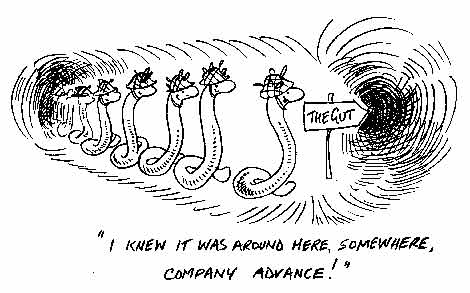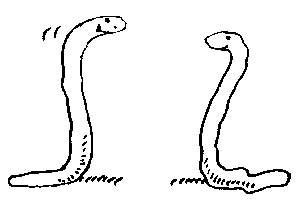|
|
An Appetite for Worms |
John Scott investigates worms and parasites and their possible therapeutic uses in respiratory and gastrointestinal disease, and in allergy. |
Not all bugs are bad According to the hygiene hypothesis we may have gone too far, too quickly, in our attempt to rid our lives of bugs, consequently leaving our immune systems out of sync with our suddenly squeaky clean lifestyles. The fact that the human immune system is now redirecting its aggressive attentions onto non-threatening targets such as foods, and even attacking the body's own tissues, is seen as a direct consequence of it being deprived of many of its traditional targets - bacteria, viruses and parasites. The theory continues to attract support from research, such as that which has demonstrated an increase in asthma risk in cases where the stomach bug Helicobacter pylori has been eradicated. It is also known that inflammatory bowel disorders, such as Crohn's disease, occur at a much higher rate in industrialised countries than in areas where gastrointestinal parasites are still common. Intrigued by the possibility that a parasite infection might cause a down-regulation of the overactive immune response seen in allergies and autoimmune diseases, the School of Pharmacy team launched a study of Necator americanus, a hookworm which has been living in humans for millions of years. The leader of the team gave himself 50 worms, causing diarrhoea, but also proving that the treatment was otherwise safe, while the researcher who had first contracted hookworms continued to enjoy the benefits of a more modest colony, without any adverse effects. In order to win ethical approval for clinical trials involving patients, the Nottingham team had to overcome the conventional wisdom that all bugs - and parasites in particular - are bad. Nevertheless, approval was eventually granted, and preliminary studies were carried out in subjects with respiratory diseases, before commencement of the current trial to assess whether it is safe to infect Crohn's disease patients with hookworm.
An immune response depends on T-cells, of which there are two types - bacteria-fighting T-helper 1, and the worm-fighting T-helper 2 cells. If the former overreact, the result is diseases like Crohn's, psoriasis, and rheumatoid arthritis. If, on the other hand, the latter cells overreact, allergies develop. Controlling these two types of immune cell are the regulatory T-cells, which are able to shut down the other defence cells before they become too aggressive and cause harm to the body. What the hookworm appears to do is somehow to increase the population of regulatory T-cells, effectively reducing the immune response. The Nottingham researchers are seeking to establish exactly how the hookworm achieves this effect, with the eventual aim of synthesizing whatever chemicals it produces and using these in the creation of more effective medicines to combat allergies and autoimmune diseases and prevent organ transplant rejection. Given the attitude to parasites which is common amongst the population at the present time, drugs rather than the bugs themselves may seem a much more attractive proposition to many patients. However, in view of the track record of synthesized medicines for producing unpleasant and even harmful side effects there is much to be said for installing a living chemical factory in one's gut which will produce the required medication on site, without interruption and without the risk of long-term side effects. Desperately seeking
infection I could, of course, have travelled to where the worms are endemic and picked up a hookworm infection by walking around barefoot in open air latrines, but the dose is difficult to control when obtained in this way and one can easily pick up something less desirable in the process. The silver lining to my eventual diagnosis of Crohn's disease was that this provided eligibility for inclusion in the 2006-2009 trial of hookworms in patients with this disorder, and I wasted no time in taking advantage of this opportunity. At my first session at the Wolfson Digestive Diseases Centre at the Queen's Medical Centre in Nottingham, the project was explained in detail by Paul Fortun, the trial team leader, and my suitability for the study was assessed. After this, all of which took place in the 'Bored Room', I was examined in another room designated the 'Hide and Caecum'! (The professor leading this department clearly has a sense of humour, further evidenced by other door signs, including those on the door of the room used by the department's two technicians. A sign high up on the door read, "High Tech", and one at the bottom, "Low Tech".) At the next session, a small amount of liquid was dispensed onto a plaster which was then applied to my arm. Contained within the liquid were either ten microscopic worm larvae, or a small quantity of histamine to act as a placebo by imitating the itch caused by the larvae as they make their way through the skin. Which of these 'treatments' I received was dependent on whether I had been assigned to the active treatment group or the placebo group but, as this was a double-blinded trial, this detail was not revealed to me, nor known by the medical staff involved. Living with wriggly lodgers If I had received hookworm larvae, these would travel first, via my blood stream, from their point of entry on my arm to my lungs. They would then hitch a ride on the upward-moving escalator of hairs lining my airways, before being swallowed, passing through my stomach, and finally settling in pairs in the lower reaches of my small intestine. And all without the aid of a satnav! As the worms are still minute when they make this epic journey, the host is blissfully unaware of any of their activity. Even when fully grown, this species of hookworm only reaches approximately 1 cm long and, although it survives by drawing blood, this is also undetectable by the host, and the amount taken is miniscule. Normal sanitation and hygiene procedures ensure that there is no danger of the worms proliferating in the host, or of infection being passed on to others. The eggs produced by the adult worms only become infectious after they have left the gut of the host and gone through a further stage of growth in soil. In order for a transfer of infection to take place, the next generation of larvae must then be picked up from the ground on bare skin, several days after the eggs were deposited. What I was hoping for most was to regain some tolerance to normal foods but, Following eradication treatment at the end of the active phase of the trial, all the positive changes were reversed and I was forced to return to a solely semi-elemental diet, leaving me to ponder whether the benefits had all been due to the placebo effect, or whether I had actually found a remarkably simple solution to many of my health problems. In order to further assess the possibility that this treatment might be of long-term benefit in my battle with multiple allergy and food intolerance, I began negotiations with my gastroenterologist and the trial team in the hope of securing a reinfection with Necator. It eventually transpired, however, that this would not be possible, but this was by no means the end of the story, which continues here.
Worm therapy opportunities At the time of the Crohn's trial, many questions remained to be answered about helminthic therapy, such as what the ideal number of worms might be, and whether top-up doses may be required during the normal five-year life span of the hookworm. Researchers were even considering whether eradication and replacement of the worms every few months might be more effective than leaving them in place long term, although this is now known not to be helpful. Further studies to try to answer these and other questions are currently in progress at Nottingham and other trials are being carried out in collaboration with researchers elsewhere in the world. A study in asthma patients has already been completed by the Nottingham team, as has one exploring the link between hookworm and allergy, and studies in Australia are focussing on coeliac disease, while a trial is about to begin at Nottingham to assess the therapy's value in Multiple Sclerosis. Would-be worm hosts who are not eligible for a clinical trial could always aquire an infection the natural way, by walking barefoot on faeces-infected ground in a part of the world where hookworms are endemic, as did one adventurous worm hunter who was desperate to cure his asthma. Details of the exploits of this brave pioneer can be read in his practical guide to the use of hookworms in the treatment of asthma and hay fever. Fortunately, a safer and more convenient option now exists, thanks to Autoimmune Therapies, who offer controlled doses of Necator to would-be worm hosts worldwide. Further information * An explanation of the theoretical framework supporting helminthic therapy. * For information on the use of helminthic therapy with specific diseases, go to PubMed and enter "helminth" plus the name of the disease you're interested in. * For up-to-the-minute discussion on all matters helminthic, visit the Yahoo Helminthic Therapy Forum or the Facebook Helminthic Therapy Support group. For a fascinating and amusing read on the subject of our complex, and sometimes comical relationship with pathogens and parasites, see 'Riddled With Life: Friendly Worms, Ladybug Sex and The Parasites That Make Us Who We Are’ by Marlene Zuk, published by Harcourt. For those who wish to purchase this infectious read, there is a link at this review.
Click here for more articles on helminthic therapies.
|














